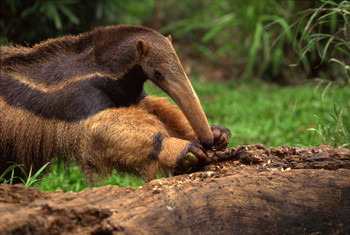Anteater Facts
Anteater Facts
|
| Interesting Anteater Facts: |
|---|
| Anteaters can be small as a squirrel (silky anteaters) or 7 feet long, counting from the tip of the nose to the end of its tail (giant anteaters). |
| Anteaters are toothless creatures. |
| They use their long and sticky tongue to catch prey. |
| Tongue can be 2 feet long. It is narrow and covered with tiny spines. |
| Anteaters catch ants and termites through the hole on the top of the anthill. |
| They never destroy anthill because they plan to come and eat another portion of ants in the future. |
| Since ants can bite, anteaters must eat them quickly. They are flicking their tongue 150-160 times in minute during feeding to grab enough ants and avoid bites. |
| Digestion is facilitated by specifically designed stomach that grinds large quantity of ants and termites. Their stomach produces formic acid instead of hydrochloric acid (which is normally found in other mammals). They can eat up to 30 000 insects per day. |
| They have poor eyesight, but excellent sense of smell. They can detect smell 40 times better than humans. Anteaters use their nose to find food. |
| Anteaters have low body temperature compared to other placental mammals, just 32.7 degrees of Celsius. |
| They sleep 15 hours per day. |
| Anteaters have 4 inches long claws and they use them to defend against jaguars and cougars. |
| Anteaters are solitary animals and they gather only during mating season. Group of anteaters is called "parade". |
| Pregnancy lasts 190 days and ends with single baby. Little anteater stays with mother 2 years or until she becomes pregnant again. Mother carries the baby on her back during the first year. |
| Anteaters live up to 15 years in the wild and 25 years in captivity. |
|
Related Links: Facts Animal Facts Animals Facts |

 Anteaters are funny-looking creatures that can be found in Central and South America. They live in grasslands, woodlands, rainforests and deciduous forests. There are four types of anteaters. Some of them are near threatened species.
Anteaters are funny-looking creatures that can be found in Central and South America. They live in grasslands, woodlands, rainforests and deciduous forests. There are four types of anteaters. Some of them are near threatened species.